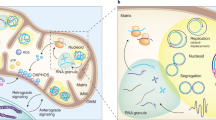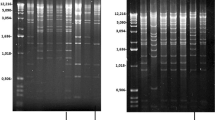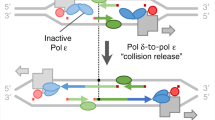Abstract
The endosymbiotic theory for the origin of eukaryotic cells1 proposes that genetic information can be transferred from mitochondria to the nucleus of a cell, and genes that are probably of mitochondrial origin have been found in nuclear chromosomes2. Occasionally, short or rearranged sequences homologous to mitochondrial DNA are seen in the chromosomes of different organisms including yeast, plants and humans3. Here we report a mechanism by which fragments of mitochondrial DNA, in single or tandem array, are transferred to yeast chromosomes under natural conditions during the repair of double-strand breaks in haploid mitotic cells. These repair insertions originate from non-contiguous regions of the mitochondrial genome. Our analysis of the Saccharomyces cerevisiae mitochondrial genome4 indicates that the yeast nuclear genome does indeed contain several short sequences of mitochondrial origin which are similar in size and composition to those that repair double-strand breaks. These sequences are located predominantly in non-coding regions of the chromosomes, frequently in the vicinity of retrotransposon long terminal repeats, and appear as recent integration events. Thus, colonization of the yeast genome by mitochondrial DNA is an ongoing process.
This is a preview of subscription content, access via your institution
Access options
Subscribe to this journal
Receive 51 print issues and online access
$199.00 per year
only $3.90 per issue
Buy this article
- Purchase on Springer Link
- Instant access to full article PDF
Prices may be subject to local taxes which are calculated during checkout



Similar content being viewed by others
References
Margulis,L. in Origin of Eukaryotic Cells (Yale University Press, New Haven and London, 1970).
Perna,N. T. & Kocher,T. D. Molecular fossils in the nucleus. Curr. Biol. 6, 128–129 (1996).
Thorsness,P. E. & Weber,E. R. Escape and migration of nucleic acids between chloroplast, mitochondria, and the nucleus. Int. Rev. Cytol. 165, 207–231 (1996).
Foury,F., Roganti,T., Lecrenier,N. & Purnelle,B. The complete sequence of the mitochondrial genome of Saccharomyces cerevisiae. FEBS Lett. 440, 325–331 (1998).
Resnick,M. A. & Martin,P. The repair of double-strand breaks in the nuclear DNA of Saccharomyces cerevisiae and its genetic control. Mol. Gen. Genet. 143, 119– 129 (1976).
Kramer,K. M., Brock,J. A., Bloom,K., Moor,J. K. & Haber,J. E. Two different types of double-strand breaks in Saccharomyces cerevisiae are repaired by similar RAD52-independent, nonhomologous recombination events. Mol. Cell. Biol. 14, 1293– 1301 (1994).
Fairhead,C., Llorente,B., Denis,F., Soler,M. & Dujon,B. New vectors for combinatorial deletions in yeast chromosomes and for gap-repair cloning using ‘split-marker’ recombination. Yeast 12, 1439–1457 (1996).
Teng,S.-C., Kim,B. & Gabriel,A. Retrotransposon reverse-transcriptase-mediated repair of chromosomal breaks. Nature 383, 641–644 (1996).
Moore,K. J. & Haber,J. E. Capture of retrotransposon DNA at the sites of chromosomal double-strand breaks. Nature 383, 644–646 (1996).
Fairhead,C., Thierry,A., Denis,F., Eck,M. & Dujon,B. ‘Mass-murder’ of ORFs from three regions of chromosome XI from Saccharomyces cerevisiae. Gene 223, 33–46 (1998).
Fairhead,C. & Dujon,B. Consequence of double-stranded breaks in yeast chromosomes: death or homozygosis. Mol. Gen. Genet. 240, 170–180 (1993).
de Zamaroczy,M. & Bernardi,G. The primary structure of the mitochondrial genome of Saccharomyces cerevisiae—a review. Gene 47, 155–157 (1986).
Roth,D. B. & Wilson,J. H. Nonhomologous recombination in mammalian cells: role for short sequence homologies in the joining reaction. Mol. Cell. Biol. 6, 4295– 4304 (1986).
Roth,D. & Wilson,J. in Genetic Recombination (eds Kucherlapati, R. & Smith, G. R.) 621–653 (American Society for Microbiology, Washington DC, 1988).
Gorbunova,V. & Levy,A. A. Non-homologous DNA end joining in plant cells is associated with deletions and filler DNA insertions. Nucleic Acids Res. 25, 4650–4657 (1997).
Sargent,R. G., Brenneman,M. A. & Wilson, J. M. Repair of site-specific double-strand breaks in a mammalian chromosome by homologous and illegitimate recombination. Mol. Cell. Biol. 17, 267–277 (1997).
Schiestl,R. H., Domiska,M. & Petes,T. D. Transformation of Saccharomyces cerevisiae with nonhomologous DNA: illegitimate integration of transforming DNA into yeast chromosomes and in vivo ligation of transforming DNA to mitochondrial sequences. Mol. Cell. Biol. 13, 2697– 2705 (1993).
Thorsness,P. E. & Fox,T. D. Escape of DNA from mitochondria to the nucleus in Saccharomyces cerevisiae. Nature 346, 376–379 ( 1990).
Thorsness,P. E. & Fox,T. D. Nuclear mutations in Saccharomyces cerevisiae that affect the escape of DNA from mitochondria to the nucleus. Genetics 134, 21– 28 (1993).
Byers,B. in The Molecular Biology of the Yeast Saccharomyces cerevisiae (eds Strathern, J. N., Jones, E. W. & Broach, J. R.) 59– 96 (Cold Spring Harbor Laboratory, Cold Spring Harbor, New York, 1981).
Farrelly,F. & Butow,R. Rearranged mitochondrial genes in the yeast nuclear genome. Nature 301, 296– 301 (1983).
Louis,E. J. & Haber,J. E. Evolutionarily recent transfer of a group I mitochondrial intron to telomere regions in Saccharomyces cerevisiae . Curr. Genet. 20, 411– 415 (1991).
Blanchard,J. L. & Schmidt,G. W. Mitochondrial DNA migration events in yeast and humans: integration by a common end-joining mechanism and alternative perspectives on nucleotide substitution patterns. Mol. Biol. Evol. 13, 537– 548 (1996).
Churcher,C. et al. The nucleotide sequence of Saccharomyces cerevisiae chromosome IX. Nature 387, (Suppl) 84– 87 (1997).
Feuermann,M., De Montigny,J., Potier,S. & Souciet,J.-L. The characterization of two new clusters of duplicated genes suggests a ‘lego’ organization of the yeast Saccharomyces cerevisiae chromosomes. Yeast 13, 861–869 ( 1997).
Goffeau,A. et al. Life with 6000 genes. Science 274, 546–567 (1996).
Baudat,F. & Nicolas,A. Clustering of meiotic double-strand breaks on yeast chromosome III. Proc. Natl Acad. Sci. USA 94, 5213–5218 (1997).
Wolfe,K. M. & Shields,D. C. Molecular evidence for an ancient duplication of the entire yeast genome. Nature 387, 708–713 (1997).
Wach,A., Brachat,A., Pohlmann,R. & Philippsen,P. New heterologous modules for classical or PCR based gene-disruptions in Saccharomyces cerevisiae . Yeast 10, 1793–1808 (1994).
Hauswirth,W. W., Lim,L. O., Dujon,B. & Turner,G. in Mitochondria. A Practical Approach (eds Darley-Usmar, V. M., Rickwood, D. & Wilson, M. T.) 171–242 (IRL Press, Oxford, 1987).
Acknowledgements
We thank F. Foury for having provided the entire mitochondrial sequence of S. cerevisiae, D. Alexandraki for the yeast strain Δykl222c , A. Harrington for purified mitochondrial DNA, A. Thierry for the Δ yme1 strategy, F. Tekaia and A. Perrin for bioinformatics, M. Buckingham and T. Pugsley for comments on the manuscript and Henri Buc in whose laboratory some of these experiments were performed. This work was supported by a grant from the European Commission (EUROFAN). B.D. is a member of Institut Universitaire de France.
Author information
Authors and Affiliations
Corresponding author
Rights and permissions
About this article
Cite this article
Ricchetti, M., Fairhead, C. & Dujon, B. Mitochondrial DNA repairs double-strand breaks in yeast chromosomes. Nature 402, 96–100 (1999). https://doi.org/10.1038/47076
Received:
Accepted:
Issue Date:
DOI: https://doi.org/10.1038/47076
This article is cited by
-
A ribonucleoprotein transfection strategy for CRISPR/Cas9‐mediated gene editing and single cell cloning in rainbow trout cells
Cell & Bioscience (2021)
-
Profile hidden Markov model sequence analysis can help remove putative pseudogenes from DNA barcoding and metabarcoding datasets
BMC Bioinformatics (2021)
-
Metabolic, structural, and proteomic changes in Candida albicans cells induced by the protein-carbohydrate fraction of Dendrobaena veneta coelomic fluid
Scientific Reports (2021)
-
Survey of mitochondrial sequences integrated into the bovine nuclear genome
Scientific Reports (2020)
-
Mosaic mitochondrial-plastid insertions into the nuclear genome show evidence of both non-homologous end joining and homologous recombination
BMC Evolutionary Biology (2018)
Comments
By submitting a comment you agree to abide by our Terms and Community Guidelines. If you find something abusive or that does not comply with our terms or guidelines please flag it as inappropriate.



